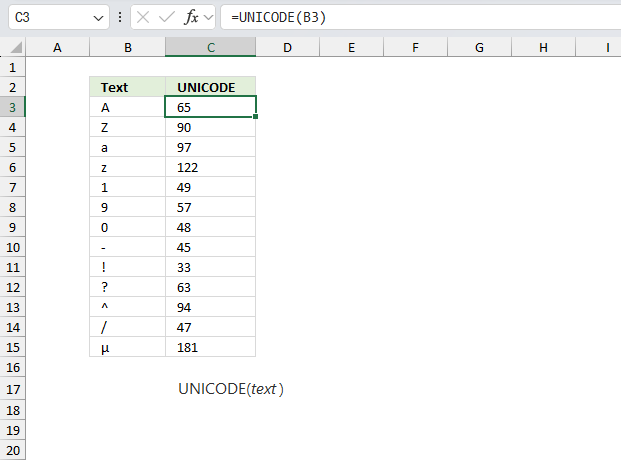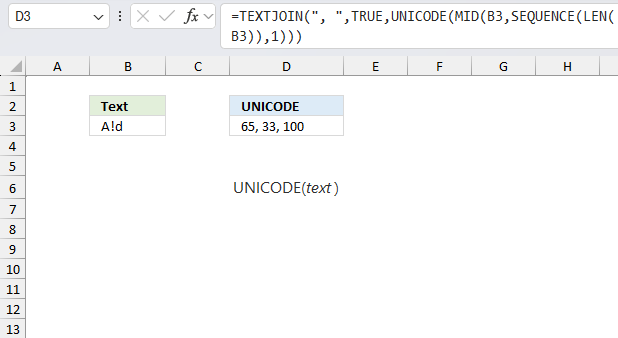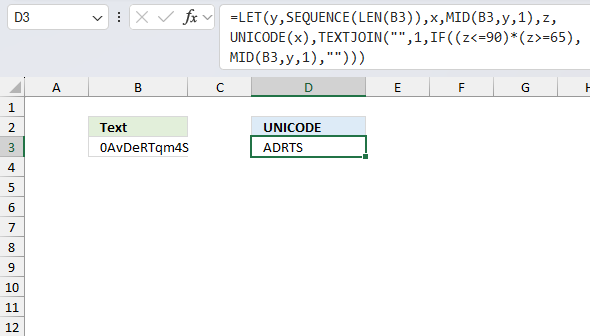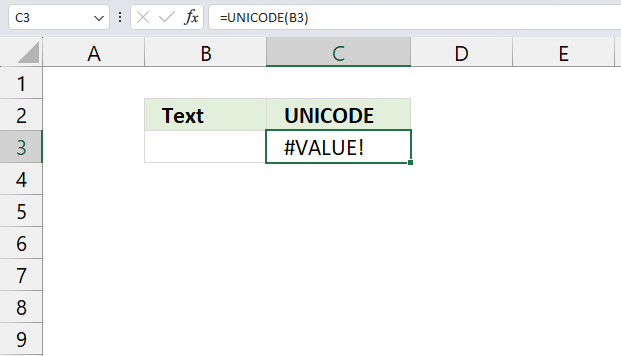How to use the UNICODE function

What is the UNICODE function?
Use the UNICODE function to return a Unicode number based on the first character of a given text string.
Table of Contents
1. Introduction
What is UNICODE?
Unicode provides a universal character set and encoding schemes to represent text consistently across computing technologies and interfaces. It supports internationalization and localization needs which enables global websites and apps to display text and accept input in any language script like Arabic, Chinese, Hindi etc. without restrictions.
- Provides a unique number for every character, regardless of the platform, device, application, or language.
- With the capacity to represent over 1.1 million characters, Unicode encompasses all the world's languages and writing systems in one unified encoding standard.
- Allows data exchange and processing of text in any language combination.
- Maintained by the Unicode Consortium and coordinated with ISO standards.
- Common Unicode encodings are UTF-8, UTF-16, and UTF-32, which provide variable length or fixed width representations.
What is a character set?
A character set is a defined collection of textual characters used to represent writing systems, symbols, and numbers. They provide a mapping between numeric codes and human-readable characters. Common character sets include ASCII, Unicode, UTF-8, Latin-1, etc.
What is the difference between the UNICODE function and the CODE function?
The UNICODE function returns the Unicode code point value of the first character in a text string, the CODE function returns the ANSI code value. UNICODE is more versatile for different languages and characters, CODE is limited to basic ANSI.
What is the difference between UNICODE and ANSI?
ANSI uses 8-bit encoding, unicode uses variable width encoding of 8-bit to 32-bit. ANSI is limited to English, unicode enables internationalization and localization. ANSI predates Unicode and is a legacy standard, Unicode is a newer standard.
2. Syntax
UNICODE(text)
| text | Required. The character for which you want the corresponding Unicode number. |
3. Example 1

The UNICODE function takes the first character in a given text string and converts it to a number representing that character's code point in the Unicode system.
Formula in cell C3:
UNICODE("A") takes the first character "A" and converts it to its Unicode code point which is the number 65.
Formula in cell C4:
UNICODE("Z") takes character "Z" and converts it to its Unicode code point which is the number 90.
Formula in cell C5:
UNICODE("a") takes character "a" and converts it to its Unicode code point which is the number 97.
Formula in cell C6:
UNICODE("z") takes character "z" and converts it to its Unicode code point which is the number 122.
Formula in cell C7:
UNICODE("1") takes character "1" and converts it to its Unicode code point which is the number 49.
Formula in cell C8:
UNICODE("9") takes character "9" and converts it to its Unicode code point which is the number 57.
Formula in cell C9:
UNICODE("0") takes character "0" and converts it to its Unicode code point which is the number 48.
Formula in cell C10:
UNICODE("-") takes character "-" and converts it to its Unicode code point which is the number 45.
Formula in cell C11:
UNICODE("!") takes character "!" and converts it to its Unicode code point which is the number 33.
Formula in cell C12:
UNICODE("?") takes character "?" and converts it to its Unicode code point which is the number 63.
Formula in cell C13:
UNICODE("^") takes character "^" and converts it to its Unicode code point which is the number 94.
Formula in cell C14:
UNICODE("/") takes character "/" and converts it to its Unicode code point which is the number 47.
Formula in cell C15:
UNICODE("μ") takes character "μ" (Greek lowercase mu) and converts it to its Unicode code point which is the number 181.
How to convert the Unicode to hexadecimal?
The UNICODE function returns a number in the base 10 numeral system. Use the DEC2HEX function to convert the number to hexadecimal.
Explaining formula
Step 1 - Convert character to unicode
UNICODE(B3)
becomes
UNICODE("A")
and returns 65.
Step 2 - Convert decimal to hexadecimal
The DEC2HEX function converts a decimal number to a hexadecimal number.
Function syntax: DEC2HEX(number, [places])
DEC2HEX(UNICODE(B3),4)
becomes
DEC2HEX(65,4)
and returns 0041 in hexadecimal.
Step 3 - Concatenate strings
The ampersand character lets you concatenate strings in an Excel formula.
"U+"&"0041"
and returns "U+0041".
What is unicode in hexadecimal?
The formal Unicode notation to represent code points uses the format:
U+XXXX
Where:
U+ - Indicates a Unicode code point value
XXXX - Is the code point specified as a 4-digit hexadecimal number
Some examples:
U+0041 - Code point for capital letter A
4. Example 2

The image above shows a spreadsheet containing a string in cell B3 which is "A!d" without double quotes. The formula in cell D3 extracts each character and returns the corresponding unicode value separated by a comma.
Formula in cell D3:
The formula in cell D3 returns 65, 33, and 100 which corresponds to A, !, and d. Here is a breakdown of the formula:
- LEN(B3): Returns the number of characters in cell B3, in this example, 3.
- SEQUENCE(LEN(B3)): creates an array containing a sequence from 1 to n. n is 3 in this case.
- MID(B3,SEQUENCE(LEN(B3)),1) : Extract each character in cell B3. {"A"; "!"; "d"}.
- UNICODE(MID(B3,SEQUENCE(LEN(B3)),1)) : Convert each character to unicode. {65, 33, 100}
- TEXTJOIN(", ",TRUE,UNICODE(MID(B3,SEQUENCE(LEN(B3)),1))): Join characters. "65, 33, 100"
5. Example 3

This example demonstrates how to extract upper case letter from a cell value. The image above displays value 0AvDeRTqm4S in cell B3. The formula in cell D3 extracts each uppercase letter from 0AvDeRTqm4S.
Formula in cell D3:
The formula in cell D3 returns ADRTS which are all upper case letters in cell B3 which contains 0AvDeRTqm4S.
Use the following formula to extract all lowercase letters:
The formula above returns veqm which are all lower case letters in value 0AvDeRTqm4S.
6. Function not working

The UNICODE function returns:
- #VALUE! error value if data type is not valid.
- #VALUE! if the unicode numbers is outside the allowed range.
- #NAME? error if you misspell the function name.
- propagates errors, meaning that if the input contains an error (e.g., #VALUE!, #REF!), the function will return the same error.
6.1 Troubleshooting the error value

When you encounter an error value in a cell a warning symbol appears, displayed in the image above. Press with mouse on it to see a pop-up menu that lets you get more information about the error.
- The first line describes the error if you press with left mouse button on it.
- The second line opens a pane that explains the error in greater detail.
- The third line takes you to the "Evaluate Formula" tool, a dialog box appears allowing you to examine the formula in greater detail.
- This line lets you ignore the error value meaning the warning icon disappears, however, the error is still in the cell.
- The fifth line lets you edit the formula in the Formula bar.
- The sixth line opens the Excel settings so you can adjust the Error Checking Options.
Here are a few of the most common Excel errors you may encounter.
#NULL error - This error occurs most often if you by mistake use a space character in a formula where it shouldn't be. Excel interprets a space character as an intersection operator. If the ranges don't intersect an #NULL error is returned. The #NULL! error occurs when a formula attempts to calculate the intersection of two ranges that do not actually intersect. This can happen when the wrong range operator is used in the formula, or when the intersection operator (represented by a space character) is used between two ranges that do not overlap. To fix this error double check that the ranges referenced in the formula that use the intersection operator actually have cells in common.
#SPILL error - The #SPILL! error occurs only in version Excel 365 and is caused by a dynamic array being to large, meaning there are cells below and/or to the right that are not empty. This prevents the dynamic array formula expanding into new empty cells.
#DIV/0 error - This error happens if you try to divide a number by 0 (zero) or a value that equates to zero which is not possible mathematically.
#VALUE error - The #VALUE error occurs when a formula has a value that is of the wrong data type. Such as text where a number is expected or when dates are evaluated as text.
#REF error - The #REF error happens when a cell reference is invalid. This can happen if a cell is deleted that is referenced by a formula.
#NAME error - The #NAME error happens if you misspelled a function or a named range.
#NUM error - The #NUM error shows up when you try to use invalid numeric values in formulas, like square root of a negative number.
#N/A error - The #N/A error happens when a value is not available for a formula or found in a given cell range, for example in the VLOOKUP or MATCH functions.
#GETTING_DATA error - The #GETTING_DATA error shows while external sources are loading, this can indicate a delay in fetching the data or that the external source is unavailable right now.
6.2 The formula returns an unexpected value

To understand why a formula returns an unexpected value we need to examine the calculations steps in detail. Luckily, Excel has a tool that is really handy in these situations. Here is how to troubleshoot a formula:
- Select the cell containing the formula you want to examine in detail.
- Go to tab “Formulas” on the ribbon.
- Press with left mouse button on "Evaluate Formula" button. A dialog box appears.
The formula appears in a white field inside the dialog box. Underlined expressions are calculations being processed in the next step. The italicized expression is the most recent result. The buttons at the bottom of the dialog box allows you to evaluate the formula in smaller calculations which you control. - Press with left mouse button on the "Evaluate" button located at the bottom of the dialog box to process the underlined expression.
- Repeat pressing the "Evaluate" button until you have seen all calculations step by step. This allows you to examine the formula in greater detail and hopefully find the culprit.
- Press "Close" button to dismiss the dialog box.

There is also another way to debug formulas using the function key F9. F9 is especially useful if you have a feeling that a specific part of the formula is the issue, this makes it faster than the "Evaluate Formula" tool since you don't need to go through all calculations to find the issue..
- Enter Edit mode: Double-press with left mouse button on the cell or press F2 to enter Edit mode for the formula.
- Select part of the formula: Highlight the specific part of the formula you want to evaluate. You can select and evaluate any part of the formula that could work as a standalone formula.
- Press F9: This will calculate and display the result of just that selected portion.
- Evaluate step-by-step: You can select and evaluate different parts of the formula to see intermediate results.
- Check for errors: This allows you to pinpoint which part of a complex formula may be causing an error.
The image above shows cell reference B3 converted to hard-coded value using the F9 key. The UNICODE function requires non-empty values which is not the case in this example. We have found what is wrong with the formula.
Tips!
- View actual values: Selecting a cell reference and pressing F9 will show the actual values in those cells.
- Exit safely: Press Esc to exit Edit mode without changing the formula. Don't press Enter, as that would replace the formula part with the calculated value.
- Full recalculation: Pressing F9 outside of Edit mode will recalculate all formulas in the workbook.
Remember to be careful not to accidentally overwrite parts of your formula when using F9. Always exit with Esc rather than Enter to preserve the original formula. However, if you make a mistake overwriting the formula it is not the end of the world. You can “undo” the action by pressing keyboard shortcut keys CTRL + z or pressing the “Undo” button
6.3 Other errors
Floating-point arithmetic may give inaccurate results in Excel - Article
Floating-point errors are usually very small, often beyond the 15th decimal place, and in most cases don't affect calculations significantly.
Useful links
Functions in 'Text' category
The UNICODE function function is one of 29 functions in the 'Text' category.
How to comment
How to add a formula to your comment
<code>Insert your formula here.</code>
Convert less than and larger than signs
Use html character entities instead of less than and larger than signs.
< becomes < and > becomes >
How to add VBA code to your comment
[vb 1="vbnet" language=","]
Put your VBA code here.
[/vb]
How to add a picture to your comment:
Upload picture to postimage.org or imgur
Paste image link to your comment.
Contact Oscar
You can contact me through this contact form